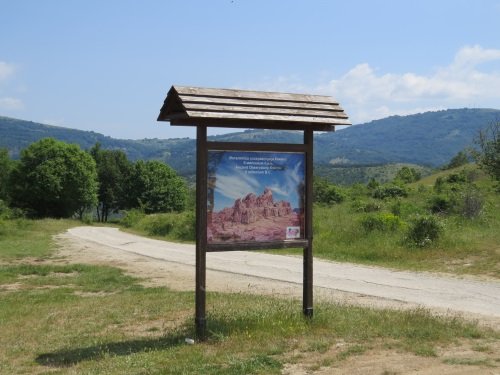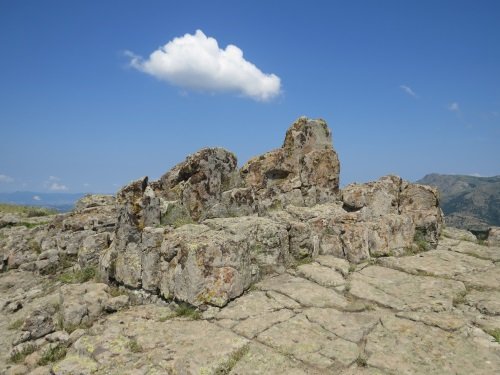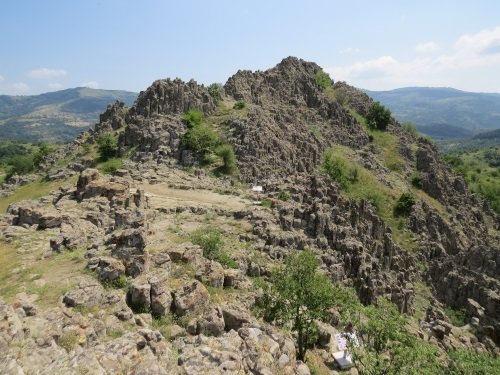The
Archaeo-astronomical Site Kokino
is a Bronze age site in the north-east of the Republic of Macedonia, not far from the border with Serbia. It was rediscovered as recently as 2001 by local archeologist Jovica Stankovski. There’s a lot of overenthusiastic misinformation about the site on the web, consisting of often repeated statements such that it is already a WHS or that it gained a 4th place among astronomical sites by NASA research. For now it is on Macedonia’s Tentative List, being put forward as an ancient observatory and holy mountain. Though it may come across as an obscure site, it is fairly well-known within the country's tourist industry.

|
|
Arrival at Kokino
|
I visited Kokino on the penultimate day of my short Balkan Tour of 2015. There’s no public transport going to the site, so I hired a car with driver from
travel-macedonia
who did the 3 hour round-trip including an hour's wait for a reasonable 40 EUR. The road to Kokino is fully signposted from the turnoff at the
Alexander the Macedonian
motorway (the country's other main motorway by the way is named after the 2nd best known Macedonian: Mother Teresa!).
The archeological site of Kokino is located at 1013 meters altitude, so when we got closer I searched diligently among the hills in the area in the hope of spotting the site from afar. Without success. After an hour’s drive we suddenly arrived at the "parking" of Kokino. Could this be it? I then noticed a rock protruding above the trees, which I recognized right away from pictures. These peculiar rocks stem from petrified volcanic lava, which has the natural tendency to split and crack.
It takes a steep climb of about 20 minutes to get up there, most through the open field. Thanks to one of the previous reviewers I knew I had to take the left path, which looks less inviting than the smooth track to the right that might be going to a nearby farm.

|
|
The Four Thrones
|
From
internet research
beforehand I learned that there are 4 stone seats (‘thrones’), 2 ritual platforms and 9 markers to 'see'. To my surprise the Macedonians even have placed 5 or so information panels at the top, to mark the various locations. Bronze Age remains were found here, proving that rituals were held. Later the theory was added that the very early Macedonians used this location for astronomy. At the top there are two flat plateaus that seem to be made by human hands. There is a kind of stone bench, with the 4 'thrones' used by dignitaries during rituals.
From these seats, but also from two more holy places a little further up, they would have been exactly at the right spot to see important days in the
calendar
like the Solstice and Equinox. At these days, the sun or moon shines exactly between a specific marker in the rocks on the ridge. I could not make any sense out of it, but it was a fun trip anyway. The odd shaped rocks, views and abundance of wild flowers make up for it.

|
|
The ridge with the markers
|
This is Macedonia’s most active TWHS – the country has tried unsuccesfully for Kokino to become a WHS in 2011 and 2012. After an incomplete dossier in 2011, it got a ‘rejection’ advice from ICOMOS a year later which made Macedonia withdraw the nomination before the WHC meeting. ICOMOS indeed is very harsh in its observations about Kokino. They do not deny it was a Bronze age sanctuary (though only one of national or regional significance), but see no scientific evidence that it was used for astronomical purposes. There is no evidence that the 'thrones' or the 'markers' are made by human hands. They are likely products of nature. Kokino is also strikingly missing from the UNESCO
list on astronomical heritage
. So maybe there is a Macedonian Erich von Däniken at work here?



